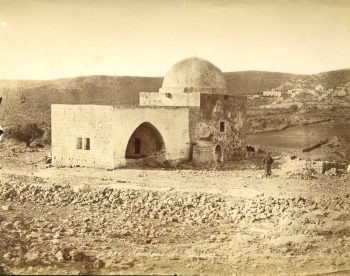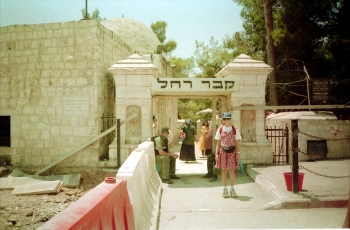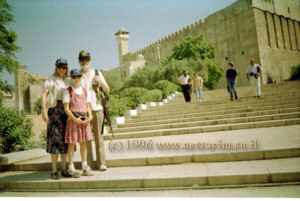wa-Yishelakh 6th Eve
Ya•a•qovꞋ Moves From ShᵊkhëmꞋ To Beit-Eil
Ël•oh•imꞋ Renames Ya•a•qovꞋ To éÄùÒÀøÈàÅì
Promises Land To éÄùÒÀøÈàÅì

 |
Feeling socially detached from, and hated by, the residents of ShᵊkhëmꞋ as a result of the incident, Ya•a•qovꞋ felt that Ël•oh•imꞋ was telling him to eliminate the foreign idols among them, purify themselves, change their clothes and move the family to Beit-Eil.
In Beit-Eil, Ya•a•qovꞋ envisioned Ël•oh•imꞋ blessing him, ennobling him with the name éÄùÒÀøÈàÅì;1 promising éÄùÒÀøÈàÅì that a goy, and a qᵊhâlꞋ goy•imꞋ that would include mᵊlâkh•imꞋ, would derive from him, and that He would deed the land that He had given to Avᵊrâ•hâmꞋ and Yi•tzᵊkhâqꞋ (not to Yi•shᵊm•â•eilꞋ), to éÄùÒÀøÈàÅì (not to his brother, Ei•sauꞋ-Ë•dōmꞋ).
Râ•kheilꞋ was pregnant and full term, as the family set off on the final leg of their journey home from Aram to Khë•vᵊr•onꞋ, Ya•a•qovꞋ called the name of the place Beit-Eil.
Enroute to Khë•vᵊr•onꞋ, Râ•kheilꞋ Dies Giving Birth to Bin•yâ•minꞋ
 |
 |
 |
As the family was almost to Ephrat, on their journey homeward from Beit-Eil to Khë•vᵊr•onꞋ, Râ•kheilꞋ went into labor. They had to stop in the village of Beit LëkhꞋëm, where Râ•kheilꞋ died in childbirth while delivering Ya•a•qovꞋ's 12th and youngest son: Bin•yâ•minꞋ.
Before departing for their ancestral home in Khë•vᵊr•onꞋ, the family erected a monument for her tomb. Each of Ya•a•qovꞋ's 11 sons laid a large flat stone, each upon the last. Then Ya•a•qovꞋ laid the twelfth and final stone atop the others.2
Finally, the family returned home to their Ma•mᵊr•eiꞋ 3 ranch in Qirᵊyat Arba 4 of Khë•vᵊr•onꞋ.
Eldest Son Rᵊu•veinꞋ Trysts With éÄùÒÀøÈàÅì's Common-Law Wife
And éÄùÒÀøÈàÅì heard about it.
While Scripture refuses to further discuss 5 this abhorrence of Rᵊu•veinꞋ trysting with Bi•lᵊh•âhꞋ, the mother of two of his brothers (Dân and Na•phᵊtalꞋi), it's unavoidable to record this incident to document why Ya•a•qovꞋ, on his deathbed, directed that the double-portion, by custom due Rᵊu•veinꞋ as the firstborn, be denied him and distributed instead to the two sons of Yo•seiphꞋ: Ë•phᵊr•aꞋyim and Mᵊnash•ëhꞋ. No further discussion, which would involve unnecessarily descending into lurid details, is warranted.
The Sons of éÄùÒÀøÈàÅì
So these were the sons of éÄùÒÀøÈàÅì:
- Rᵊu•veinꞋ, éÄùÒÀøÈàÅì's first-born
- Shi•mᵊōnꞋ
- Lei•wiꞋ
- YᵊhudꞋâh
- Yi•sâ•khârꞋ
- Zᵊvul•unꞋ
- Yo•seiphꞋ
- Bin•yâ•minꞋ
- Dân
- Na•phᵊtalꞋi
GodandAshꞋeir.
These include the sons born to Ya•a•qovꞋ in Pad•anꞋ-A•râmꞋ.
After sitting shiv•âhꞋ in Beit LëkhꞋëm for Râ•kheilꞋ, Ya•a•qovꞋ arrived home to his father, Yi•tzᵊkhâqꞋ, at the Ma•mᵊr•eiꞋ 3 ranch in Qirᵊyat Arba 4 of Khë•vᵊr•onꞋ, home of Avᵊrâ•hâmꞋ and Yi•tzᵊkhâqꞋ.
Death of Yi•tzᵊkhâqꞋ
 |
| Mᵊâr•at′ ha-Ma•khᵊpeil•âhꞋ, in Khë•vᵊr•onꞋ (photo © 1996 Yirmeyahu Ben-David |
Yi•tzᵊkhâqꞋ toiled 180 years and then he died.6 éÄùÒÀøÈàÅì and Ei•sauꞋ buried Yi•tzᵊkhâqꞋ in the Mᵊâr•at′ ha-Ma•khᵊpeil•âhꞋ, in Khë•vᵊr•onꞋ beside their grandfather, Avᵊrâ•hâmꞋ.

Optional parental preparation:
- Note 1 – Having battled the battle of Eil in ShᵊkhëmꞋ (spurning intermarriage with idolaters, ridding the family of idols and moving away), he had reinforced his earlier win over his brother.

- Note 2 – bᵊ-Reish•itꞋ 35.19; Yi•rᵊmᵊyâhꞋu 31.15

- Note 3 – Ma•mᵊr•eiꞋ, associated with an earlier Amori ( bᵊ-Reish•itꞋ 14.13) and his idolatrous A•shᵊr•âhꞋ of oak trees, may be derived from ma (meaning "from the") + a•mᵊr•eiꞋ (Amorim)

- Note 4 – Fourthville, town 4, subdivision 4.

- Note 5 – Sages, rabbis and other commentators have concocted all manner of explanations for an account that, in the SeiphꞋër Tor•âhꞋ, finishes mid-sentence, leaving the remainder of the line blank, then moving on to start a new verse. Simply, either the account was deleted by the earliest extant documenters as too abhorrent or, more likely, the earliest documenters regarded the statement as sufficient and refused to descend into lurid details discussing it further. When (sometime in the 7th-10th centuries C.E.) the Masoretes introduced the vowels, they faithfully reproduced the mid-sentence cut-off. But when, centuries after that, gentiles introduced verses and it became a "mid-verse mystery," rabbis and other interpreters with vivid imaginations concocted "filler" stories to explain the non-existent "void in the verse."

- Note 6 – While different peoples used different calendars (primarily lunar, then solar) during different eras, the 180-year lifespan of Yi•tzᵊkhâqꞋ isn't readily explainable by either solar or lunar calendar. In an era in which long-term calendar chronology hadn't even been conceived, archeologists suggest that venerated personalities were conventionally "awarded" fictional additions of years to their lifespan (or reign of a ruler) as a mark of respect. While that may have elevated the memory of some of their greatest ancestors in the minds of the ancients, such a practice may have made mathematically precise chronology of modern scientists a very muddy patchwork. In this instance, it would appear viable that a noble century was "awarded" to Yi•tzᵊkhâqꞋ, whose actual lifespan, in that case, would have been a viable 80 years—still more than double the typical ancient lifespan.

Questions you might anticipate that your child might raise and be prepared to discuss:
- What is a tryst? Parents should be prepared how they wish to handle this topic.
- What is a "common-law wife"?
Google+ registered author & publisher

